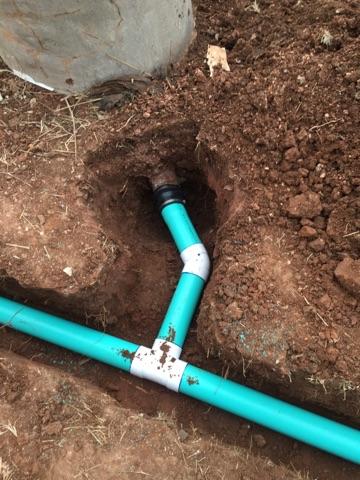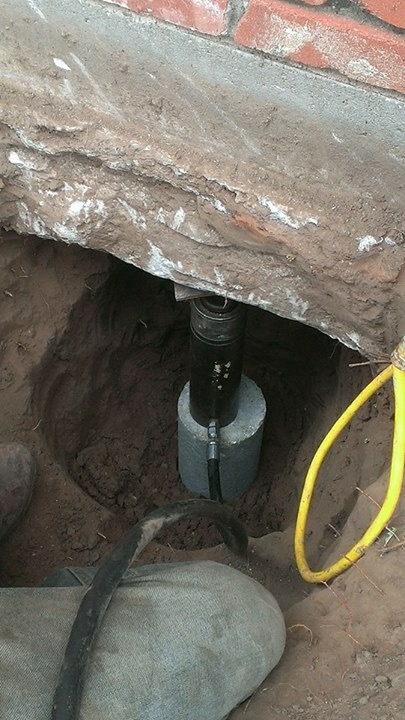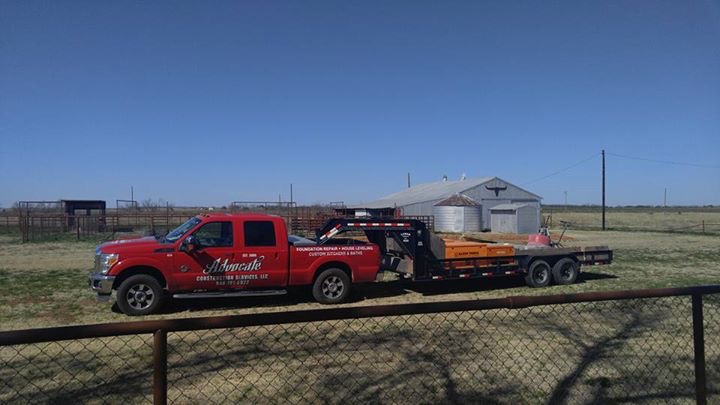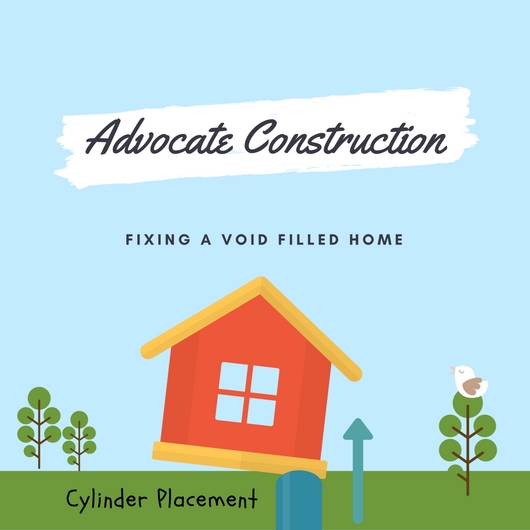Understanding the World of Foundation Repairs

How Many Types of Foundation Repairs Are There?
If you’ve seen the scary image (shown above) at your own home, you’re not alone. Right now, Texas is experiencing a heavy season of Fall rains. Although this type of weather is common for September & October, it’s not meant to be weathered by your foundation.
Home Foundations are typically built using a construction technique called Slab-on-Grade. Simply put, the home builder levels & compacts (or they should compact) the soil. Secondly, they lay a grid network of reinforced steel bars (i.e. rebar) and pour a concrete slab. Typically concrete slabs are 4″ thick but you can find them up to 5″ or 6″ for areas that experience heavy rains. It all depends on the level of investment the home builder places into your residence.
Often slab-on-grade foundations are what we see in the North Central Texas region. For areas of dry to moderate seasons with perfect non-expansive soil conditions, this type of construction should be sufficient. However, for North Central Texas and other areas that contain Expansive Clay Soils, this is not enough. Let’s find out why!

The Science Behind Soil Movement
Now before, we can dive into the “why” of foundations, let’s understand the principles that are key to your understanding as a home owner. First things first – all foundations rest upon the uppermost layer of soil. In almost all cases, these soil layers are uneven and consist of various blends of soil compositions. Some soil mixtures have high affinity for moisture (high absorbency & expansion rates); other’s allow water to pass through with little interruption. In all cases, what we look at is the distribution of moisture levels (a.k.a. differential) beneath the foundation.
Differential Movement
Various conditions impact the Differential Movement – degree your even foundation movement due to of moisture equilibrium. In almost all cases, moisture is not evenly dispersed beneath the foundation of your home. We can likely find areas of high moisture content (causing swelling) & low moisture content (causing settling) at various points throughout your home.
The American Concrete Institute (ACI)… allows the elevation of two points 10-feet apart to be different by as much as 1.25 inches. – texasinspector.com
Knowing that all slabs move due to the natural expansion and contraction that occurs between moisture & soil, we depend on standards set by the ACI to determine acceptable tolerance levels. Problems arise when the rises (upheaval) or falls (settling) are greater than the 1.25″ allotted by the ACI standards. Deviations greater than 1.25″ often lead to cracking of drywall, shifting of slabs, angling of doors & windows and a wide host of other issues.
Advocate Construction Services LLC specializes in the repair and prevention of future movement via our Advocate Foundation division. We utilize the science of Underpinning by installing a series of Piers, Beams, Shims & Hydraulic Lifts to rescue settling homes. Conversely, we harness the power of polyurethane foam injection to fill the voids beneath your home structures. This allows us to lessen the impact of differential movement, by causing the house to lift (upheaval) & lower (settle) as one unit.

Ways to Protect Your Home’s Foundation
After each foundation repair that we make, we educate our clients on ways to proactively protect their homes from future movement. In many cases, foundation repairs provide the tools necessary to stabilize the home. However, the success of our operations often rest in the behavior aspects of foundation maintenance.
Foundation Maintenance is the principle of caring for your home and preventing moisture from getting the upper hand on your foundation. When trying to understand this principle, just remember one thing: water wins! In all areas of home ownership, water has the capacity to rot, move, destroy & wear down any aspect of your home. Although water is necessary for life and the beauty of your lawn, too much of it is not a good thing.
Therefore, we educate our clients on ways to protect their home from the advancement of water over time. These methods include:
- Slope Maintenance – always ensure that the areas along your exterior wall encompass a slope that moves water away from the structure of your home
- Drainage Maintenance – inspect and clean out all gutters, sub-surface drains, deck drains, and any other irrigation equipment in and around your home. Water needs a path to escape and it’s imperative to periodically inspect all of these elements to ensure that water is able to move away from the home and not puddle up
- Irrigation & Sprinkler Systems – regularly check your irrigation lines for leaks. If left untended, your sprinkler system can allow the uneven dispersion of water beneath your foundation – leading to differential movement.
- Brick, Rock & Crack Repairs – cracks occur naturally in the exterior of your slab. However, allowing these cracks to remain creates doorways for moisture & water inside the foundation of your home. This can lead to material deterioration, voids and settling.

Always Watch The Water!
Lastly, the best way to protect your home from potential foundation issues is to “Always Watch The Water.” By doing so, you’re taking an active step to regularly check your home for potential threats due to moisture & differential movement.
When inspecting your home, it’s important to remember that water is a natural material that will always find it’s way back into your soil. Your job as a homeowner is to check for signs of movement, puddling, cracking, shifting and any other strange sign. In essence, you’re looking for ways that water is gathering too strongly and in too much force against the slab of your home.
In most cases, taking precautionary steps (such as the Foundation Maintenance items, listed above) can protect your from costly repairs in the future. Whatever course of action you need to take to protect or repair your foundation, Advocate Construction Services LLC is here to help! We will gladly assist you with any Foundation Maintenance or Repair service and educate you further on ways to protect your home for the long run. Our true purpose is to be a Advocate for all of our clients. If we’ve protected you and your home, we’ve done our job!
Check Out Our Other Job Articles
The Avondale Job – Complete Fire Restoration on Centennial Home
